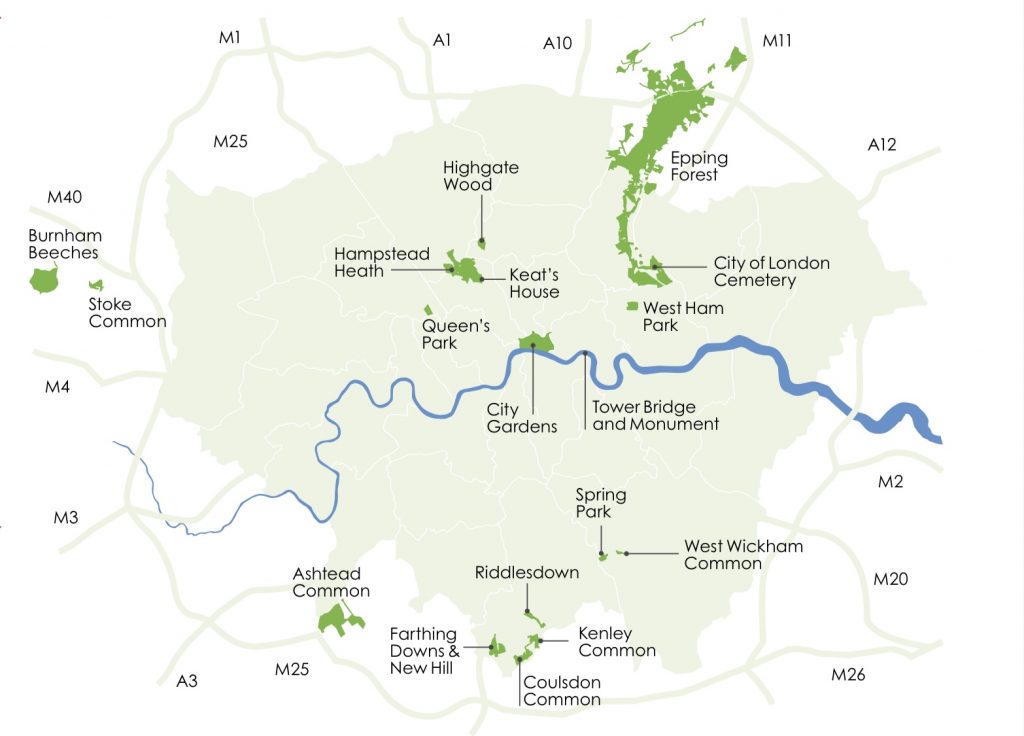
The City of London Corporation manages a large number of open spaces across Greater London, Essex, Buckinghamshire and Surrey. These include more than 150 gardens, churchyards, water fountains and courtyards. The single largest open space in Greater London and Essex is Epping Forest, at 2,400-hectare (5,900-acre) of ancient woodland running from Epping to Forest Gate. It is 12 miles long and 2.5 miles wide. In addition to maintaining the Forest itself, over the past 60 years, the City of London also purchased an additional 14 parcels of buffer land totalling 735 hectares (1,800-acre) to help preserve the environmental setting, landscape heritage and quality of the Forest.
So why is Epping Forest so special? It is one of the very few large, ancient forests in Britain and it has a lot of rare or important habitats like ancient semi-natural woodland, wood-pasture, old grassland plains, heathlands and wetlands. It has 55,000 veteran pollarded trees – more than anywhere else in the UK. 85% of the UK’s veteran beech pollards are in Epping Forest, as are over 1,500 fungi species – one of the most diverse populations in the UK and in Europe. It has more than 550 protected species living within it. Commonly known as the lungs of London, Epping Forest has special legal and planning/development protections to safeguard it for future generations. 1,728 hectares (4,270 acres) is designated a Site of Special Scientific Interest and a Special Area of Conservation.
So why is managing Epping Forest so complicated? The boundary of the forest is 320km with 189km of paths, 101 ponds, 55 car parks, 43 football pitches, 7 listed buildings, 3 scheduled monuments, 3 visitor centres, 2 Grade II listed parks and gardens, 1 museum, 4 golf courses, 3 cricket fields and 207 traditional grazing cattle. In addition, the Forest has more than 13 million visitors every year.
How is the Forest governed? UK Parliament passed the Epping Forest Act in 1878 conveying ownership and responsibility to the City of London Corporation. On 6 May 1882 Queen Victoria visited Chingford to open Epping Forest dedicating it ‘to the enjoyment of my people for ever’. Epping Forest became a registered charity of which the corporate trustees are the City of London Corporation, with delegated management responsibility to the Epping Forest & Commons Committee.
How is the Forest funded? Costs differ from year-to-year, but as a registered charity, the trustees must raise funds to ensure it is maintained as an open space of high standards. Money is raised through retail sales and licensed events, sports income from golf, rental income from tenants, grant applications for government agencies, car parking charges, and the surplus comes from the City of London’s philanthropic investment portfolio. The total cost is approximately £10m a year, predominantly driven by the 110 employees working for the charity. We are also blessed with hundreds of generous volunteers who donate their time.
Ben currently sits on the following Open Spaces Committees:
Natural Environment Board
West Ham Park Committee
Epping Forest & Commons Committee (Chairman)
Epping Forest Consultative Group (Chairman)
Ashtead Common Consultative Group (Chairman)
Burnham Beeches and Stoke Common Consultation Group (Chairman)
West Wickham, Spring Park and Coulsdon Commons Consultation Group (Chairman)
Other helpful information and links:
Burnham Beeches & Stoke Common Consultative Group